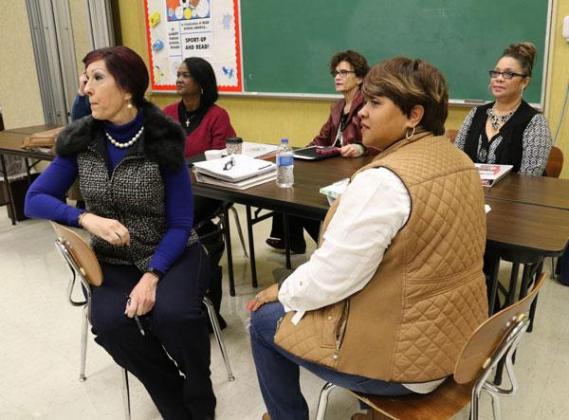
Harlan Kirgan
About 50 people attended a St. Landry Parish School Retreat on Saturday in Opelousas. From left, are Lorie LeDoux, Highland Elementary principal: Mary Dupre, Gifted and Talented Program administrator; Mary Ellen Donatto, District 13 School Board member; Dwanetta Scott, Eunice Junior High School principal; and Ranolviaun Landry, Central Middle School principal. (Photos by Harlan Kirgan)
School Board retreat
Life after desegregation order is among topics discussed
Patrick Jenkins, right, St. Landry Parish School Board superintendent, leads a discussion during the School Board Retreat on Saturday.
By Harlan Kirgan
Editor
OPELOUSAS — When a federal desegregation order was lifted from the St. Landry Parish School Board in August 2016, authority for many decisions returned to the board, Bob Hammonds, board attorney, said at an all-day retreat Saturday.
The retreat held at the Supplementary Resource Center was attended by all but two of the 13 board members — Charles Ross and Milton Ambres.
Several staff members also were present for a retreat led by first-year superintendent Patrick Jenkins for topics ranging from core values, the budget to leadership.
Roger Young, a Eunice area board member who has served since 1987, said the retreat was the first related to the school district for him.
“It will bring us together, bring us together as one,” he said. “I think we are a point where we are forgetting the race problems we’ve had and hopefully this will be one of the media by which we can improve and get things done...”
Dwanetta Scott, Eunice Junior High School principal, said the retreat is a step in a positive direction.
“It makes everyone have a stronger sense of ownership in the direction that we would like to take our students,” she said.
“It speaks of where the superintendent is trying to take St. Landry Parish to have all stakeholders involved,” Scott said.
Jenkins, who was named superintendent in October, said he plans to do another retreat possibly within six months, but nothing definite has been set.
“I thought it was a great retreat. Very informative for the board members as well as staff and principals that were in attendance,” he said.
The retreat was educational as well as a team-building experience, he said.
Hammonds said the discussion on what a school system does after a desegregation order is lifted is rare in Louisiana.
Many school systems have operated under desgregation orders, he said.
St. Landry Parish’s desegregation order began in 1965.
“...we’ve told them what they have to do to become unitary. What steps do they have to take to fully desegregate and get these 50- and 55-year-old cases dismissed,” Hammons said.
“What we haven’t done very often, however, is to have the situation to stand up before a board and say, ‘You are there. You are done. You are totally unitary. Your case is dismissed. Everything is done. Now what can you do?’” he said.
“As of this summer the federal court ruled that your system has satisfied all constitutional obligations,” he said.
“That is a huge change because in the past whenever a system wanted to do anything it had to consider the black and white of it. It had to consider the racial balancing of it, or racial imbalance of it,” he said.
The St. Landry Parish school system has about 600 students who transfer out of their school districts based on a majority to minority system.
It is a system that is gone with unitary status, he said.
“You have to start thinking about it from perspective of what is best for your students and what is best for your school system,” he said.
The offer to transfer students from a school in which they are in the majority to one where they are in the minority involved costly busing, he said.
The unitary status also means the school district does not have to consider race in hiring, he said.
Hammonds said the return of community schools may be possible.
“Now if you do something not with the intent to discriminate, but simply with the intent to save money with the intent to reduce transportation, with the intent to move kids closer to home ... that’s perfectly permissible even if that intent has a result that puts you a situation where schools may be all black, all white or whatever,” he said.
Under the desegregation order, the school district had to prove it did not have the intent to discriminate, he said.
“From this point on, the other side has to prove you deliberately intended to do something to discriminate on the basis of race,” he said.
Hammonds said the board may want to review its school district lines to make better utilization of facilities, along with evaluating the facilities.
Hammonds cautioned, “When you talk about closing schools, when you talk about consolidating schools, when you talk about moving student attendance zones, there is very little, if anything, that you will ever do as a board member that is more controversial.”
Unitary status means, “One-hundred percent of the control of the school system is back in the hands of the board members,” he said.
While the Legislature has given superintendents power over employees, Hammonds said board members still determine bus routes, the number of schools, number of employees, location of schools, admission policies and attendance zones.
Bob Hammonds, St. Landry Parish School Board attorney, talks about the lifting of an desegregation order.
